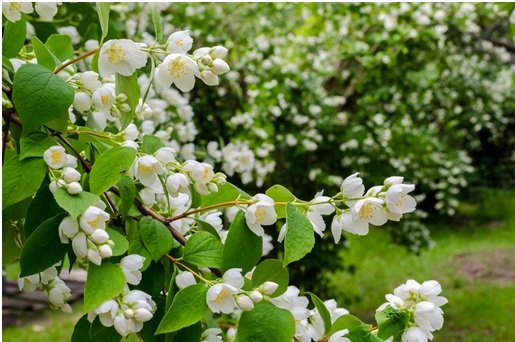How to Plan for Jasmine and Other Flower Plants in Your Garden
The first step is to make flowerbeds in your garden for the multiple flower species you wish to gown in your jasmine garden. A wider bed allows the roots to expand and grow deeper. The distance between two plants should be a minimum of three to four feet if the plants can grow into a small size tree. You don’t need to worry about the roots, as they have a natural way of avoiding each other. It is only the branches which may tangle and prevent each others’ growth.
Jasmine Garden
Rose, marigold, hollyhock, carnation, viola, lobelia, and cosmos are some of the most commonly grown flowers with jasmine flowers.

Jasmine Bed Size
An average jasmine plant grows to a height of ten feet. The average size of every leaf is 2.5”. The average jasmine plant can spread to a width of two feet to three feet. Hence, you have to ensure so much space for each plant in the bed. The number of plants in each bed determines the dimension of the bed.
Rose Bed Size
Rose can grow to a size of six feet at an average. The different types of rose may have variable heights. The average bed size of a rose plant could be between 16 feet and 20 feet in length if the number of plants is five. The average width will be between 3 feet and five feet. You have to consider the space between two rose plants for their free growth.
Marigold Bed Size
The space required for each marigold plant is 40cmX40xcm within the bed. The distance between each plant should not be less than four inches. You may plant the marigold in rows and columns within the bed. So, you can calculate the net dimension required based on the number of plants. Make sure that the space from the bed edge and the last plant is also being four inches.
Similarly, you can calculate the bed sizes for other plants, based on the input given by the gardener near your home.
Soil ph
Though it is not possible to change the soil condition of a large garden, you can certainly do it for the small soil bed. You can replace the topsoil to a depth of six feet for the length and breadth, based on the soil type required by the specific flowering plant. You have to test the soil ph condition regularly. If there is a variation, you have to restore the original condition. You can get the advice from the horticulture specialist near your home.
Watering Methods
Every flowering plant may have a specific type of watering requirement. But all the flowering plants grow well with drip irrigation. It is a simple method by which only one drop of water is supplied to the bottom of the plant stem near the ground soil. You can change the frequency according to the flowering plant species.
Fertilizing Method
Mulch from the leaves and branches of trees in your garden is stated to be the natural and healthy fertilizer.
This article is courtesy of our friend at Gold Coast Tree Lopping.
Gold Coast Tree Lopping
1/58 Milbrook Crescent Pimpama 4209
(07) 5646 3714
https://www.goldcoasttreeloppingqld.com/

